|
Philips SPP 70
Genre: Globe lantern
Since the earliest days of lighting, the glare from a point light source could always be
softened and reduced by means of a diffusing globe or sphere. Although the gentle light
produced by the early gas lanterns never merited any diffusing glass, the arrival of
the arc lamps necessitated huge opaque glass globes required to soften and spread
the piercing light of the electric arc.
When the incandescent bulb arrived, some exterior lanterns offered a choice of either
clear flint glass or opaloid glass, but the function of the lantern was still to protect
the bulb(s) and provide an even symmetrical distribution of light. It wasnít until the 1920s,
the scientific foundations of street lighting, and the development of directional lanterns,
that the globe lantern fell from favour as a general street lighting lantern.
It was relegated to the back of catalogues as a "decorative" lantern. By the 1930s,
the globe lantern was pushed into service on elegant columns and brackets, as a focal
point on bridges, boulevards, public spaces, parks and other open areas. Its optical
control was limited to just its diffuser bowl.
During the austere 1950s, it had all but disappeared from the manufacturers catalogues
and it certainly didnít fire the imagination of the design conscious 1960s. (Its two main uses
being limited to the orange globes of Belisha Beacons and the white sphere of the refuge island lantern).
But, it reappeared in the 1970s; companies such as the GEC and Phosco
placed their street lighting optical systems within the globe itself, thus embellishing the
lantern with modern street lighting optics whilst maintaining its classical daytime appearance.
Other companies also jumped on the bandwagon, but simply returned to the old idea of placing a
bare lamp in a spherical diffuser.
The spherical lantern is still popular, but todayís push for ever more efficient lanterns and
strict control of light means the upper hemisphere of the lantern isn't illuminated in modern
versions. Therefore its daytime appearance doesn't match its night apperance. It remains
to be seen if authorities will continue favouring this version of the globe lantern.

Name: Philips SPP 70 (Precinct)
Date: Circa 1970s - 1980s
Dimensions: Length: 450mm, Height: 450mm
Light Distibution: None.
Lamp: 70W SON.
History
 The Philips SPP 70 probably appeared in the mid 1970s when it replaced the earlier spherical MU8 post top lantern.
Externally it smoothed the lines of the earlier lantern, replacing the spigot with a clamp with matched the globeís circumference, thus emphasising the
lanternís shape.
The Philips SPP 70 probably appeared in the mid 1970s when it replaced the earlier spherical MU8 post top lantern.
Externally it smoothed the lines of the earlier lantern, replacing the spigot with a clamp with matched the globeís circumference, thus emphasising the
lanternís shape.
Unfortunately no catalogues have surfaced featuring this lantern its dates of manufacturer and bowl and bulb options are unknown.
It has since been discontinued and references cannot be found in the Philips catalogue or online. The closest modern relative is a member of the
Philips Urbana range; but that offers a transparent globe with much improved optical control.
Popularity
Such globular lanterns were limited to precincts, shopping centres, civic areas, seaside promenades and other
open areas which required both decorative and non-directional lighting. Whilst this was the situation in the UK,
it was vastly different in Europe, where such lanterns were used extensively as road lighting.
They were most effective near buildings or foliage where upward emitted light was put to good effect. However, given
the lack of optical control, these lanterns had a very low utilisation factor, and werenít used for general road
lighting (although this doesnít seem to have been an issue in Europe).
Itís probably no coincidence that this lantern was also dubbed the Philips Precinct.
Whilst still common, these lanterns have started to disappear from the UK streets. Their complete lack of light control and low
utilisation factor rendered them obsolete in todayís requirements for energy-efficient lanterns and dark-skies.
Identification
The identification of near identical opalescent globe lanterns is tricky. Normally itís only possible to differentiate
lanterns by means of their spigot fixings; but luckily, in the case of the Philips SPP70, the
Philips logo can be found on the base of the clamp. Thereís also a sticker inside the lantern stating the lanternís
make, catalogue number and bulb wattage and type.
Optical System
None. The globe acts as a universal diffuser casting light in all directions.
The Philips SPP70 In My Collection

|
|
facing profile / front profile / trailing profile
This lantern used to stand in the grounds of Norwich University where it was part of a large installation which lit the campus.
The date on the capacitor suggests the lantern was manufactured (and installed) in 1983.
|
|

|
|
canopy
Whilst still clean and tidy, the plastic globe is covered with a network of tiny cracks on the surface.
This cracking is most extensive near the top of the globe where the effect has blackened the top. However,
these cracks havenít affected the structural integrity of the globe, which still remains extremely strong,
but they do give the lantern a 'dirty' appearance.
|
|

|
|
pedestrian view
The band around the globe has an interesting story behind it. Norwich University was being used as a film location for a futuristic
television series. The director found the existing lighting just a little too bland for his tastes and asked for it to be jazzed up somehow.
Hence this lantern was removed and beefed up with the metal band.
However, I also believe Iíve seen similar banded lanterns in other locations, so perhaps this story should be
taken with a small pinch of salt!
Note the vertical shadow on the right of the globe. This is caused by a small optional light shield which limits the amount of
light emitted vertically from the lantern.
It would appear this lantern was manufactured by Philips and wasn't cosmetically altered:
I think they replaced normal SPP 70 lanterns by the banded SPP 70 lanterns.
I have an catalogue of Philips from 1977 and both lanterns are mentioned
only with older names and have the older spigot: HPC 131 for the banded
and HPC 133 for the non banded sphere. Later (mentioned in my catalogue
of 1983) with the new spigot in the Netherlands the names become SPP 133
for the non banded sphere and SPP 131 for the banded one. Both lanterns
were popular in the Netherlands in the past.
Sanders
|
Philips SPP 70 - Installation
The lantern is made of three main pieces; the spigot adaptor, bottom clamp and gear, and the white plastic
diffuser.
The spigot adaptor fits into the top of the column with a lip allowing it to sit neatly on top. A
diagonally tapped locking screw allows the spigot to be fixed in position; a hole has been drilled in
the spigotís wall to allow access to the screw.

The spigot has now been attached to the top of a piece of cast iron piping. This will act as the column for photographs.

Wiring is attached to a plastic terminal block assembly which pushes into the base of the gear compartment.
This allows the entire lantern to be replaced without any rewiring. The live screw had rusted in-place in
my lantern, which is why an extra terminal block is required. The two extensively rusted Philips screws
at the base of the assembly carried the cable clamp (which has perished).

The bottom clamp and gear comprises two curved pieces of metal which act as a clamp to hold the
plastic diffuser in place. Upon this is mounted the lamp control gear, lamp holder bridge, lamp holder and optional light shield.
In this shot, the identification sticker can be seen but most of it has disintegrated.

The plastic terminal block assembly engages with the terminal block in the centre of the gear assembly whilst a
lock nut (the access hole can be seen drilled in the top clamp below the sticker) allows the whole assembly
to be locked to the spigot cap.
On this side, the original Paramar Ignitor (for 35-70W HPS)
and original Philips power correction capacitor can be seen (L4010/67 10uF).

The original Philips ballast (BSN 70L 66) has failed in the past, and has been replaced with
a new Philips ballast (BSN 70L 32).
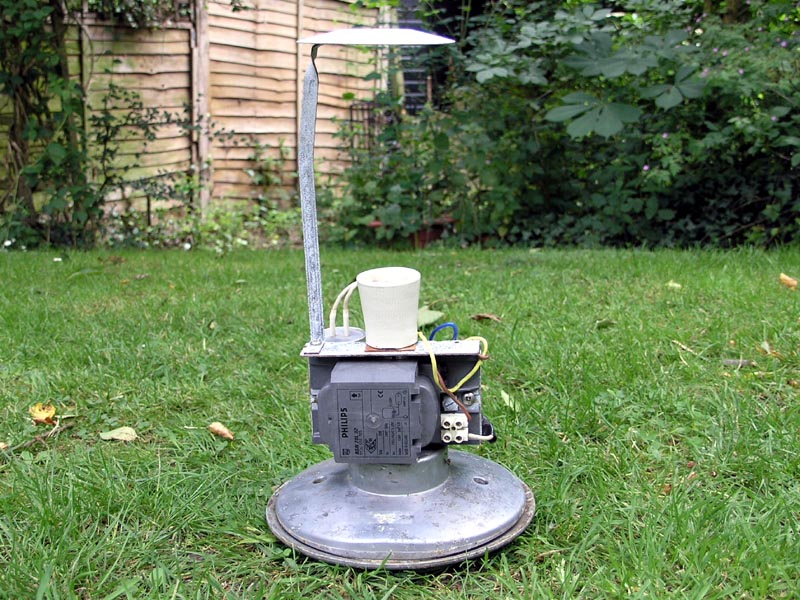
The base of the bottom clamp shows the spigot entry hole and the gap for the terminal block assembly. The
Philips logo can also be seen along with arrow marks; I believe these are to guide the fixing
of the globe in position. The two Allen bolts bring the two clamps together, thus tightening themselves around
the base of the globe diffuser, creating a water-tight seal and ensuring the entire lantern is solid.
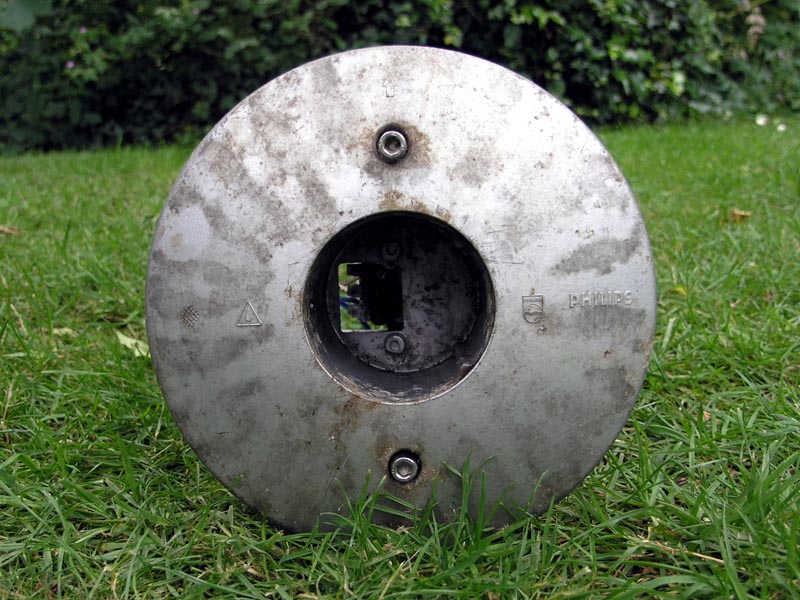
The bottom clamp and gear assembly has now been mounted onto the spigot. The terminal assembly
has been pushed into the terminal block and the lock nut tightened so the assembly is solid on the column.
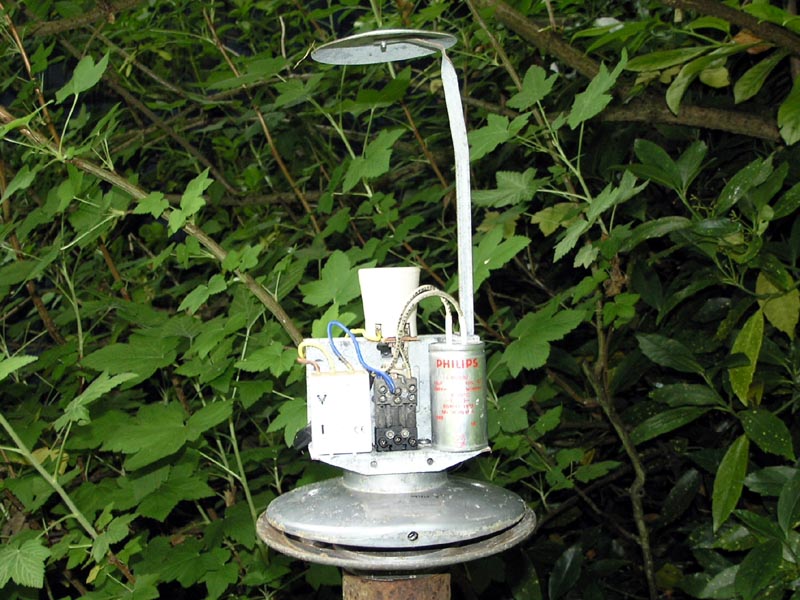
A 70W SON-T bulb is now screwed into the lamp holder. Without the globe diffuser, this gives
a piercing pink/orange light and its remarkable how the diffuser softens the light.
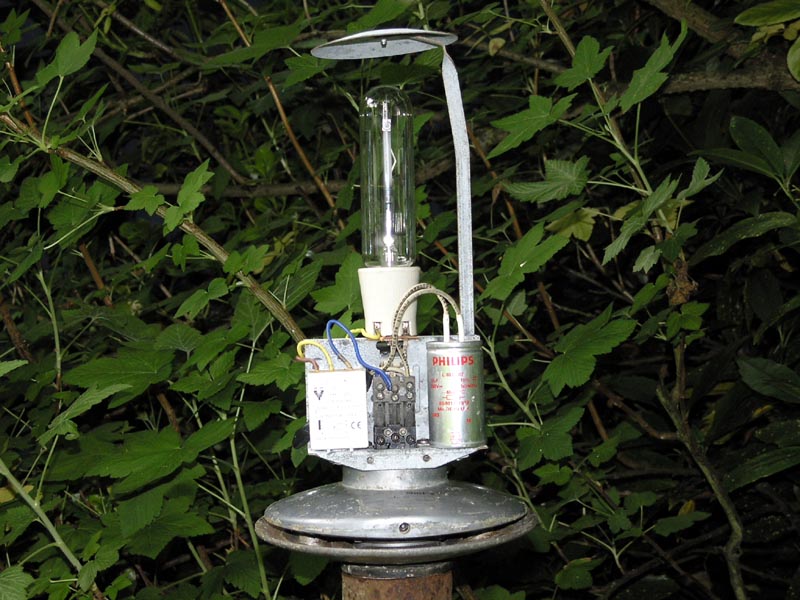
Finally, the globe itself is slipped between the two clamps, and the allen bolts on the base of the clamp
assembly are tightened until the whole unit is solid.
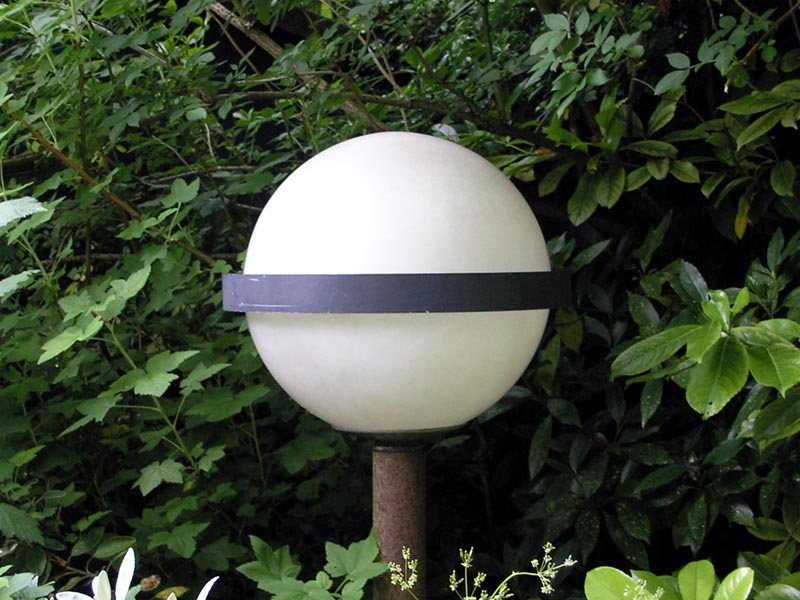
Philips SPP 70 - Other Shots
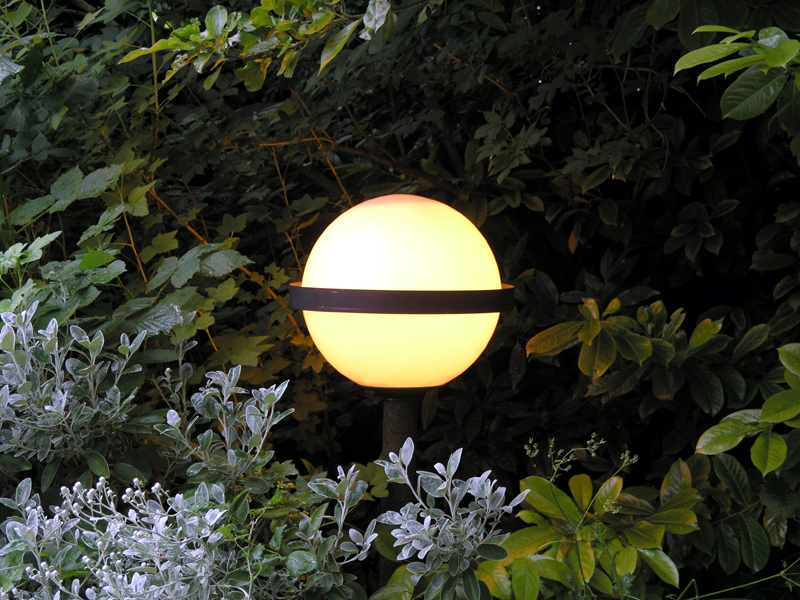
Daylight appearance of the Philips SPP 70. The white horizontal
strip across the centre of the globe (which can be seen on my other Philips SPP70) is hidden
by the metal band.
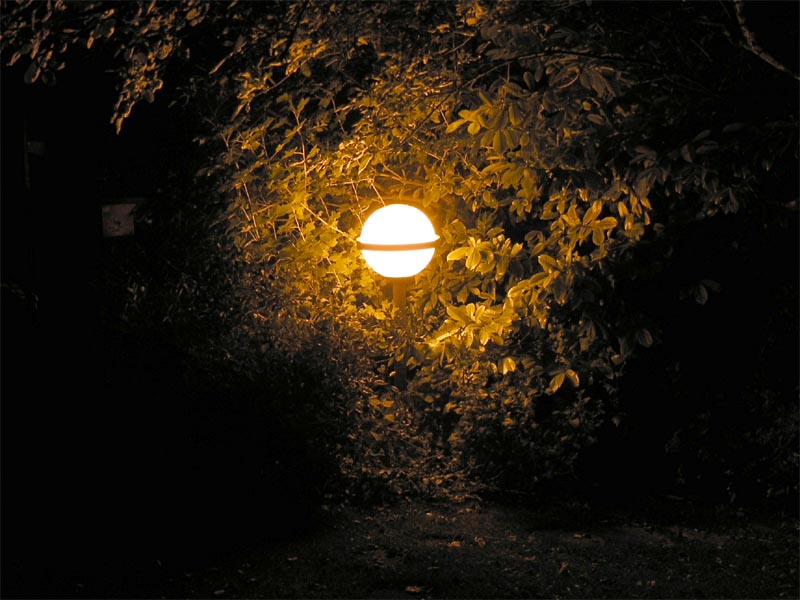
Night appearance of the Philips SPP 70. Note how the area all around the lantern is illuminated; there is no light control.
|



